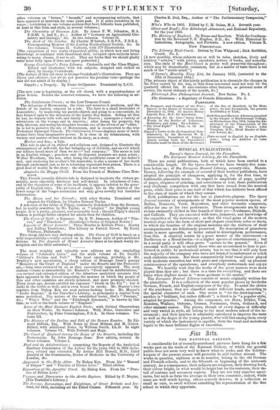THE NATIONAL GALLERY.
A considerable lot of recently-purchased pictures have hung for a few weeks past on the walls of the National Gallery, of which the general public does not seem very well to know what to make, and the holiday- keepers of the present season will probably be still further abroad. The works in question, eighteen or so in number, belong to the old German and Flemish schools, and to the fifteenth or beginning of the sixteenth century. Asa consequence, their subjects are religious, their drawing hard, their colour bright, or what would be bright but for the restorers, their de- tail of costume and accessory copious. They are not very superior speci- mens, but such as form the average in their own countries ; indeed, while 'some are well worth having, others scarcely deserve, in a collection so small as ours, to swell without ennobling the representation of the fine school to which they appertain.
Perhaps Meister von Liesborn, the author of five or six of them, fur- nishes the best of the series, in the heads of the Virgin, St. Damian, an.!, another male saint, whose names appear pricked in on the gold nimbuses around their heads. Those who can appreciate this form of art will find its good gifts present here in no contemptible degree. The Crucifixion and the Annunciation by the same master may also be remarked ; the latter painted over by some flat-headed restorer, like only too many others of the set. The St. Hubert's Conversion by Meister von Werden is another work of some worthy qualities ; the figure of the saint himself being one of the best made-out in character among all. The Viz gin and Child of Ludger zum Ring is as skilful in execution as any. The want of refined feeling in the Infant Saviour spoils it, however, for higher pur- poses; though this is a blemish common to the best men of the school. A Vander Meeren has some of the clever jewellery so distinctive of such productions. As for the Lambert Lombard—a man of a later school, who was not a native Lombard, but a Fleming—it IS merely coarse, self-sufficient, and feeble.
The Lorenzo di San Severino—a fine work, of whose purchase wo have before spoken, but which was not hung when we last alluded to the National Gallery—is now in its place, and bespeaks a word of praise to the Trustees for its selection.
On the general question raised by the choice of works of the earlier schools, our favourable opinion is no novelty. Still, it is very desirable that strict discrimination as to the individual instances should always be exercised ; not only because we do not want inferior specimens of those schools any more than of others, but because the display of them only retards the growth of public taste, persuading the partially-informed into a false estimate of the schools generally, and gives a handle to the advocates of the later art, however academic and barren. Recent in- stances show that this caution is not altogether unneeded by the Trus- tees of the National Gallery, laudable as we recognize their intentions to be.







































 Previous page
Previous page